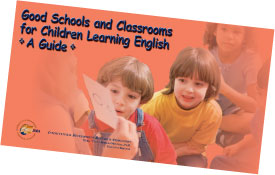• by Kristin Grayson, Ph.D. • IDRA Newsletter • June-July 2017 •
 Teachers and administrators may feel overwhelmed by the use and analysis of data for English learners (ELs) as is required by the federal guidelines under Title III of the Every Student Succeeds Act. Yet collecting and conducting data analysis is essential for EL success and is based on strong and seminal research in second language acquisition. Using data is even more critical when students are secondary level newcomers and English learners with interrupted schooling.
Teachers and administrators may feel overwhelmed by the use and analysis of data for English learners (ELs) as is required by the federal guidelines under Title III of the Every Student Succeeds Act. Yet collecting and conducting data analysis is essential for EL success and is based on strong and seminal research in second language acquisition. Using data is even more critical when students are secondary level newcomers and English learners with interrupted schooling.
When considering how to collect and use data, the Casteñeda v. Pickard decision of the Fifth Circuit Court,1981, provides an excellent framework (Thomas & Collier, 1997). As described in the DOJ-OCR Dear Colleague Letter (2015), this ruling states that public school districts’ language programs need to satisfy three requirements.
(1) “The educational theory underlying the language assistance program is recognized as sound by some experts in the field or is considered a legitimate experimental strategy;
(2) “The program and practices used by the school system are reasonably calculated to implement effectively the educational theory adopted by the school; and
(3) “The program succeeds, after a legitimate trial, in producing results indicating that students’ language barriers are actually being overcome within a reasonable period of time.” (Lhamon & Gupta, 2015)
 This article focuses on the data needed to support teachers and English learners who enter U.S. schools as newcomers and as students with interrupted schooling. IDRA’s Good Schools and Classrooms for Children Learning English ~ A Guide (Robledo Montecel, et al., 2002) and its supplement for secondary students also provide a way to collect much of the needed data.
This article focuses on the data needed to support teachers and English learners who enter U.S. schools as newcomers and as students with interrupted schooling. IDRA’s Good Schools and Classrooms for Children Learning English ~ A Guide (Robledo Montecel, et al., 2002) and its supplement for secondary students also provide a way to collect much of the needed data.
Research Base of an Effective Instructional Program for ELs
The language assistance program needs to be based on research that shows evidence of being successful. The language program description should be available in the district handbook and on the district website. It also should be available for non-English speaking families in a language they understand. Regular communications about EL students and their progress in the language program should be provided to families in their home language, and this should be documented as well.
Program Implementation and Resources
Districts should document implementation with fidelity to the program model. This can be done in a variety of ways, including instructional observation of ESL and content/grade level teachers using a rubric that is designed for the program model.
Observations should be conducted several times per year in order to ensure that implementation is occurring consistently. In addition to instructional implementation, all campus staff should be surveyed to ensure that they understand the program that is in place in their campus.
It is essential that ESL and content area teachers be experienced and successful with the instructional techniques that they need to implement based on the English learners who are in their classrooms. Professional development enhances the skills of teachers and increases their self-efficacy in delivering appropriate instruction. Such ongoing professional development for all teachers involved in the instruction of English learners also needs to be documented.
ESL and other teachers additionally need to have access to resources that allow for the differentiation of instructional techniques, especially for alternatives to standard textbooks and to content appropriate texts written at different literacy levels that challenge but do not overwhelm English learners. Other resources needed may include visuals, flashcards and other manipulatives that teachers might use during instruction.
Documentation of Program and Student Progress
When looking at student data and progress, some of the most essential questions to first ask newcomer English learners concern their educational experiences in their first language. Did they go to school in their home country and, if so, what grade level did they complete? What were their grades or scores? How long was their schooling interrupted before they enrolled in the first or current U.S. school?
The district should assess the students’ home language. For example, the LAS test or Woodcock Muñoz test is available to assess Spanish proficiency. Attainment in English and the home language combined can be assessed with the BVAT, which includes 17 languages in addition to English. Using other assessments, such as the Aprenda, can reveal achievement in core academic areas in Spanish.
Background information is critical to share with ESL and classroom teachers. Research has shown that higher language proficiency in the home language correlates with quicker attainment of English language proficiency, as shown in many quantitative studies by Wayne Thomas & Virginia Collier.
This also is based on the seminal theoretical work of Jim Cummins and the Common Underlying Proficiency hypothesis (CUP) (1979). What is learned in one language can easily be transferred to another language. It is important to understand students’ literacy level in their home language and how reading is learned in that language.
By law, each English learner annually takes an English language proficiency test, which results in scores for listening, speaking, reading and writing in English as well as a composite score. The scores are important for secondary teachers to understand, particularly the scores in reading and writing. These scores inform teachers about what students can currently do and what they can be expected to achieve to move forward. Based on the (i + 1) comprehensible input hypothesis of Stephen Krashen, this explains that students can only comprehend and perform at one level higher than their current level of proficiency (1956).
English proficiency can only be attained over time. For secondary English learners, the time it takes to gain proficiency is based on many individual factors as well as similarities and differences of the home language to English and the sociocultural context in their school and community (Thomas & Collier, 1997). English proficiency data should be viewed using long-term longitudinal analysis that focuses on the long-term parity implied in the Casteñeda v. Pickard court case.
If secondary English learners are behind in reading and writing in English, teachers should focus on giving students comprehensible input (for the appropriate content) at their own level of instruction with a wide range of vocabulary usage. Vocabulary in context and as chunks of words, rather than words in isolation, will help newcomers and English learners with interrupted schooling, as described in psychologist’s George A. Miller initial works about language, short-term memory and cognitive functions (1956).
Stephen Krashen’s reading and writing hypotheses supports this approach for helping secondary students learn to read (1982). The more students read something at their literacy level and that is of interest to them, the more progress they will make in reading and vocabulary building. In turn, the better readers that students are, the better writers they will become, and this in turn will engage their cognitive functioning.
Funding and/or the lack of funding for language programs remains a critical issue for successful programs. While EL data collection and analysis may seem overwhelming, it is necessary that it be based on seminal research, as well as case law and policies that can help districts achieve the intent of the Lau v. Nichols Supreme Court decision of 1974. This ruling indicates that a lack of supplemental language assistance violates the Civil Rights Act of 1964.
Today, districts can gather and analyze the data of the language assistance that they are providing to show that it is a supplemental language program that helps English learners succeed in progress and attainment of English proficiency and academic achievement.
The IDRA EAC-South is helping districts in the U.S. South articulate and improve their language assistance programs and is ready to help your district.
Resources
Cummins, J. (1979). Cognitive/Academic Language Proficiency, Linguistic Interdependence, the Optimum Age Question and Some Other Matters. Working Papers on Bilingualism. (19), 121-129.
Firelight Media. (2004). “Summary of Lau v. Nichols 1974,” Beyond Brown: Pursuing the Promise (Harriman, N.Y.: Firelight Media & PBS). https://www-tc.pbs.org/beyondbrown/brownpdfs/launichols.pdf
Houghton Mifflin Harcourt. (2017). Bilingual Verbal Ability Tests, (Boston, Mass.: Houghton Mifflin Harcourt). http://www.hmhco.com/hmh-assessments/bilingual/bvat
Krashen, S. (1982). Principles and Practice in Second Language Acquisition (Oxford: Pergamos Press, Inc.). http://www.sdkrashen.com/content/books/principles_and_practice.pdf
Lhamon, C.E., & Gupta, V. (January 7, 2015). Dear Colleague Letter: English Learner Students and Limited English Proficient Parents (Washington, D.C.: U.S. Department of Education & U.S. Department of Justice). https://www2.ed.gov/about/offices/list/ocr/letters/colleague-el-201501.pdf
Miller, G.A. (1956). “The Magical Number Seven, Plus or Minus Two: Some Limits on Our Capacity for Processing Information,” in Malinowski, S., The Psychological Review (63), pp. 81-97. http://www.musanim.com/miller1956/
Purposeful Design Publications. (2017). LAS Links Online Digital Library, website (Colorado Springs, Colo.: Purposeful Design Publications). http://pdp.acsi.org/pdp/Category/109_1/Language_Proficiency.aspx
Robledo Montecel, M., & J.D. Cortez, A. Cortez, A. Villarreal. (2002). Good Schools and Classrooms for Children Learning English: A Guide (San Antonio, Texas: Intercultural Development Research Association). http://www.idra.org/publications/good-schools-classrooms-children-learning-english-guide/
Shoebottom, P. (2011). “An Introduction to the Work of Stephen Krashen,” A Guide to Learning English, website (Oberursel, Germany: Frankfurt International School). http://esl.fis.edu/teachers/support/krashen.htm
Thomas, W., & Collier, V. (December 1997). School Effectiveness for Language Minority Students (Washington, D.C.: National Clearinghouse for Bilingual Education). http://www.thomasandcollier.com/assets/1997_thomas-collier97-1.pdf
U.S. Department of Education. (October 2015). The Biennial Report to Congress on the Implementation of the Title III State Formula Grant Program School Years 2010-12 (Washington, D.C.: U.S. Department of Education). http://www.ncela.us/files/uploads/3/Biennial_Report_1012.pdf



